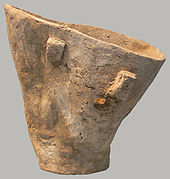Reute (Bad Waldsee)
|
Tail
City of Bad Waldsee
|
|
|---|---|
| Coordinates: 47 ° 54 ′ 0 ″ N , 9 ° 42 ′ 0 ″ E | |
| Height : | 579 m above sea level NHN |
| Residents : | 2400 (Sep 6, 2007) |
| Incorporation : | 1st December 1971 |
| Postal code : | 88339 |
| Area code : | 07524 |
Reute has been part of the town of Bad Waldsee in the Ravensburg district in Baden-Württemberg since 1971 . Today the place has around 2400 inhabitants. Reute also includes the Durlesbach, Greut, Magenhaus, Obermöllenbronn, Stadel, Tobel and Untermöllenbronn residential areas.
history
Archaeological finds in Schorrenried indicate a settlement around 3700 BC. Chr. The Neolithic village was located on a small lake that has silted up today. In the moor settlement of Reute-Schorrenried , house horses, remains of wooden structures, wooden objects and a copper dagger were found, which is considered to be the oldest metal weapon in southwest Germany (today in the Württemberg State Museum in Stuttgart ).
The name Reute refers to an Alemannic clearing settlement, which is confirmed by row graves that were found during an expansion of the monastery. The name "Luibrathesriute", which was in use until 1300, refers to the elder of the clan, who probably lived in the fourth century on the site of today's Gasthof Sonne.
After the Napoleonic occupation, Reute came to Württemberg in 1806 , after it had belonged to Upper Austria since 1331 . In 1849 the Durlesbach train station, which was part of the municipality and was also responsible for Waldsee until 1869 (see Württembergische Südbahn ), was built.
On December 1, 1971, Reute was incorporated into the city of Bad Waldsee.
Only since 2014 has Gaisbeuren and Reute merged it into Reute-Gaisbeuren.
The monastery of Reute
In 1403 five women founded the Reute Franciscan monastery. One of these women was the beatified Waldseer Elisabeth Achler (1386–1420), known today as Gute Beth. Around 1770 the monastery was forcibly closed.
In 1869, sisters from Ehingen acquired the monastery buildings and revitalized the monastery as Franciscan Sisters of Reute . Today the "Klosterberg" is the place of life and work for over 200 Franciscans and the origin of numerous missionary activities that extend as far as Indonesia and Brazil.
On October 14, 1939, four omnibuses of the so-called “ Gemeinnützige Krankentransport GmbH ” (Gekrat) brought about a hundred disabled men and a few women from Grafeneck Castle , which was converted into the Grafeneck killing center, with the couple Frank, his daughter and ten employees, who were in charge of the home Monastery. The von Reute sisters had been informed four days earlier by the Württemberg Ministry of the Interior that they had to vacate their St. Elisabeth retreat house immediately. All patients who were housed in Reute survived action T 4 .
In 1999 the Franciscan Sisters of Reute set up the St. Elisabeth Foundation .
The "Gut-Betha-Brunnen" and the Franziskuskapelle can be visited in the monastery district. A park with stations of the cross and the spacious monastery cemetery invite the visitor to linger a while.
The baroque parish and pilgrimage church at the top of the "Klosterberg" with the grave of Good Beth and frescoes from her life are particularly worth seeing on a tour of the monastery grounds.
Ceiling fresco by Eustachius Gabriel
Former Durlesbach train station
The Durlesbach station was known by the folk song " de In schwäbsche Eisebahne ". The train station is closed today, the building houses a gallery.
On a siding on the station premises, the events described in the folk song are illustrated with bronze figures using a real steam locomotive and two railroad cars: a farmer ties a billy goat to the train and is observed by the conductor (conductor) and the farmer's wife.
leisure
Sports
The soccer club SV Reute eV was founded on July 7, 1950 in the Drei König inn .
music
On March 9, 1975, the founding meeting of the 'Fanfarenzug Reute' took place in the Reute sports center. In February 1976, under the direction of Konrad Veser, the first public appearance followed with the uniforms in the local colors of blue, red and gold.
The Durlesbach Schalmeien Reute eV were founded in 1982 in Reute near Bad Waldsee and are therefore one of the oldest shawm trains in the Upper Swabia region.
Individual evidence
- ^ Federal Statistical Office (ed.): Historical municipality directory for the Federal Republic of Germany. Name, border and key number changes in municipalities, counties and administrative districts from May 27, 1970 to December 31, 1982 . W. Kohlhammer, Stuttgart / Mainz 1983, ISBN 3-17-003263-1 , p. 531 .
Web links
- Durlesbach (Bad Waldsee: Reute district)
- Catholic parish of Reute-Gaisbeuren
- Franciscan convent Reute in the database of monasteries in Baden-Württemberg of the Baden-Württemberg State Archives
- Reute local authority
- Spiegel online: There is a train in the hallway - Durlesbach station










